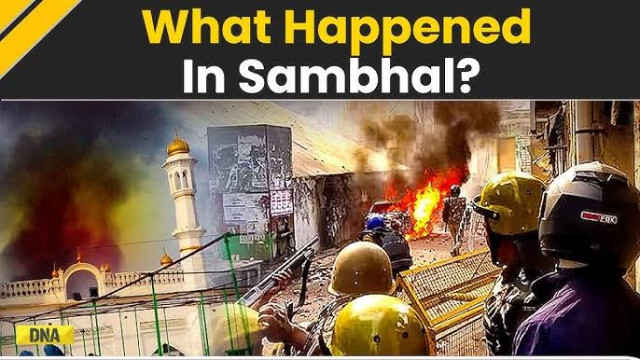Ratan Tata Death: A Look Back At The Legacy Of India’s Visionary Leader
- Posted on 30-11-2024
- Politics
- By Anshu Kumar
- 205 Views
In late November 2024, Sambhal, a district in Uttar Pradesh, witnessed a violent incident that has sparked widespread concern. The violence, which unfolded in the form of clashes between two communities, has highlighted both existing tensions and underlying issues in the region. The events are a stark reminder of the fragile communal harmony in parts of Uttar Pradesh and the socio-political challenges that continue to affect many districts

What Happened in Sambhal?
The violence reportedly began on November 24, 2024, when a dispute between members of two communities in the district escalated into physical clashes. According to local reports, the incident was triggered by a minor altercation, which quickly spiraled out of control. The situation worsened as groups from both sides gathered, leading to stone pelting, arson, and even reports of gunfire. The police intervened to contain the situation, but by then, significant damage had been done.
The violence resulted in several injuries, and at least one person was reported dead. Local businesses were damaged, and vehicles were set on fire. Additionally, there were reports of a tense atmosphere in the region, with curfews imposed in certain areas and a heavy police presence to maintain order.
Underlying Causes of the Violence
While the immediate cause of the violence appeared to be a personal dispute, experts argue that the incident was exacerbated by deeper, long-standing issues. The region has been home to complex socio-political dynamics, where religious and caste tensions occasionally flare up. Several factors contributed to the outbreak of violence:
Communal Tensions: Sambhal is a diverse district, with a significant Muslim population alongside Hindu communities. Communal tensions in Uttar Pradesh, especially during election seasons or religious festivals, can often amplify underlying social divisions, making the region more susceptible to clashes.
Political Instability: The political climate in Uttar Pradesh, particularly in districts like Sambhal, is highly competitive and sometimes polarized. Local politicians, seeking to solidify their support bases, have sometimes resorted to playing the communal card. This creates an environment where tensions are more easily ignited, even by small incidents.
Socio-Economic Inequality: Economic disparity, unemployment, and lack of opportunities can contribute to social unrest. In regions where frustration over poverty and underdevelopment exists, minor grievances can escalate into larger conflicts.
Religious Sentiments and Festive Periods: Violence often peaks around religious festivals or sensitive periods, where emotions run high. In Sambhal, like many parts of India, the heightened religious fervor during festivals can sometimes serve as a backdrop for clashes.
Government Response and Security Measures
In the wake of the violence, local authorities acted swiftly to contain the situation. The Uttar Pradesh Police increased their presence in the affected areas, and additional paramilitary forces were deployed to maintain law and order. Authorities imposed a curfew in some sensitive areas to prevent further violence and to avoid any retaliation.
The district administration, under the guidance of the Uttar Pradesh government, initiated efforts to restore peace, including reaching out to community leaders and religious figures for reconciliation. Additionally, appeals for calm were made by local politicians and religious heads, urging people to refrain from engaging in violence and to prioritize dialogue over conflict.
Impact on the Community and Future Challenges
The violence in Sambhal has raised significant concerns regarding the fragile communal fabric in the region. The immediate impact is seen in the disruption of daily life, with businesses suffering losses and the local population feeling unsafe. The scars of violence often linger, leading to mistrust between communities, which can take years to heal.
The broader implications of such incidents are felt in the form of increased insecurity, migration, and deepening divides between communities. In the context of Uttar Pradesh's larger political narrative, these events often fuel polarization, which can affect the outcome of future elections and the stability of local governance.
The Road Ahead: Ensuring Long-Term Peace
To avoid the recurrence of such violence, a more sustained and proactive approach is required. Key actions should include:
Community Engagement: Efforts to build inter-community trust through dialogue and joint initiatives can help address underlying issues of suspicion and resentment.
Strengthening Governance: There is a need for more effective law enforcement, better training for police forces in managing communal tensions, and a neutral political leadership that doesn't exploit religious divisions for electoral gains.
Economic Development: Tackling socio-economic inequalities, such as unemployment and poor infrastructure, is crucial to reducing the frustration that can lead to violence. Creating opportunities for youth and investing in local industries can provide a sense of hope and stability.
Educational and Social Reforms: Promoting inclusive education and social reforms that emphasize tolerance and understanding among different communities can help reduce the long-term potential for violence.
Conclusion
The violence in Sambhal, though tragic, serves as a reminder of the deep-rooted challenges faced by many regions in India, where socio-political tensions are still very much alive. It also underscores the importance of prompt government action, community engagement, and efforts towards social cohesion. As the district recovers, it will be important for authorities, local leaders, and the community at large to work towards healing the rifts that have emerged and to ensure that peace prevails in the future.



-oOcAkcjgw0.jpeg)